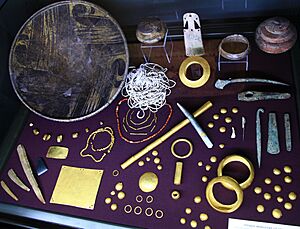Varna culture facts for kids
| Horizon | Old Europe |
|---|---|
| Period | Chalcolithic |
| Dates | c. 4550 BC – c. 4,100 BC |
| Type site | Varna Necropolis, Solnitsata, Durankulak |
| Preceded by | Karanovo culture, Hamangia culture, Gumelnița culture |
| Followed by | Cernavodă culture |
The Varna culture was an ancient civilization that lived in northeastern Bulgaria around 4500 BC. They were part of the Copper Age, a time when people started using copper tools. This culture is famous for having some of the oldest gold items ever found in the world. These amazing golden treasures, dating from 4600 BC to 4200 BC, were discovered in a burial site called the Varna Necropolis. You can see them today at the Varna Archaeological Museum.
The Varna Necropolis was found by accident in October 1972 by a digger operator named Raycho Marinov. Later, archaeologists Mihail Lazarov and Ivan Ivanov led the research. About 30% of this important burial site is still waiting to be explored.
Contents
What Was the Varna Culture Like?
The Varna culture is known for its colorful pottery and very rich cemeteries. The most famous sites are the Varna Necropolis and the Durankulak lake complex. The Durankulak site has the largest prehistoric cemetery in southeastern Europe. It also has an old village from the same time period.
Archaeologists have found 294 graves at the Varna Necropolis. Many of these graves contained incredible examples of the world's oldest gold work. They also found copper tools, about 600 pieces of pottery (some painted with gold), high-quality flint and obsidian blades, beads, and shells.
The oldest gold jewelry from the necropolis dates back to 4,600 BC to 4,200 BC. Other ancient gold items have been found in Bulgaria, like treasures from Hotnitsa, Durankulak, and Solnitsata. However, the Varna gold is often called the oldest because it is the largest and most varied collection.
Trade and Resources
The Varna culture traded with people from far away places. They might have traded with groups from the lower Volga region and the Cyclades islands. They probably exported metal goods and salt from the Solnitsata rock salt mine.
The copper ore used for Varna artifacts came from a mine near Stara Zagora. Also, Mediterranean spondylus shells found in the graves might have been used as a type of early money.
Burial Customs
The Graves at the Varna Necropolis show the earliest known examples of gold working in the world. People were buried in different ways. Some were buried with their knees bent (crouched), and others were laid out straight (extended).
Interestingly, some graves did not have a skeleton inside. They only contained grave gifts. These symbolic (empty) graves were often the richest in gold items. In total, about 3000 gold artifacts were found, weighing around 6 kilograms. Three symbolic graves also had masks made of unfired clay.
"Varna is the oldest cemetery yet found where humans were buried with abundant golden ornaments. … The weight and the number of gold finds in the Varna cemetery exceeds by several times the combined weight and number of all of the gold artifacts found in all excavated sites of the same millenium, 5000-4000 BC, from all over the world, including Mesopotamia and Egypt. … Three graves contained gold objects that together accounted for more than half of the total weight of all gold grave goods yielded by the cemetery. A scepter, symbol of a supreme secular or religious authority, was discovered in each of these three graves." (Slavchev 2010)
Beliefs and Society
The Varna culture had complex religious beliefs. They thought about the afterlife and had different social classes. Grave 43 shows the oldest known burial of an important male leader. Some experts have even called these Varna leaders 'kings'.
Around 5000 BC, some historians believe that male leadership started to become more common in Europe. The important male in Grave 43 was buried with a lot of gold. He also had a war axe or mace and wore a fancy gold belt tip. Gold plates shaped like bulls might have represented strength and power.
Gallery
See also
- Early European Farmers
- Old Europe (archaeology)
- Boian culture
- Butmir Culture
- Cucuteni–Trypillia culture
- Funnelbeaker culture
- Hamangia culture
- Karanovo culture
- Gumelnița culture
- Lengyel culture
- Linear Pottery culture
- Sesklo culture
- Solnitsata
- Starčevo culture
- Tisza culture
- Vinča culture
- Old European script
- Carnac Stones - Tumuli















